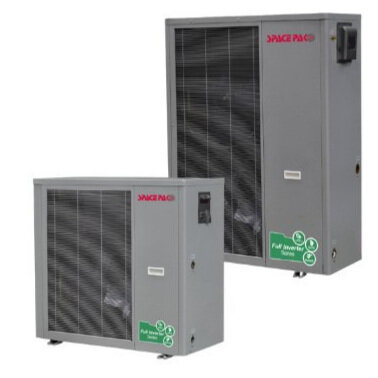Eric Fenno Pipes Up about the Benefits of Hyronic Heating
/Small Planet Supply’s eric fenno at his Tumwater branch command module,
Our March 2024 webinar is focused on hydronics and will feature Small Planet Supply’s Eric Fenno. We interviewed Eric to learn more about why he wanted to do this webinar and how it can help our customers who might be considering a hydronic system in their home or build.
You brought forward the idea of doing a webinar is focused on hydronics. What do you find appealing about using hydronics in a high-efficiency build?
Hydronics are fantastic for so many reasons. Flexibility is one, most people think radiant when hydronics are mentioned, but hydronic air handler coils are a great option for retrofits with existing ductwork trying to get away from gas or electric. For new builds or radiant applications, the efficiency of water as a heating medium allows for relatively compact distribution hardware, less power being used to heat the space, and in the case of radiant floors or panels, extremely quiet operation. Radiant also helps keep your building envelope tight, as water line penetrations are relatively small and easy to air seal. Also, modern radiant "emitters" (fan coils, radiant floor, radiant panels) have low temperature requirements and work great with heat pumps, making it a fantastic choice for an efficient electric home. In some cases, radiant cooling is also possible! It's not just for cold climates. And of course there's the comfort factor, I haven't talked to too many people who disliked their radiant floor.
Harvest Thermal (Now known as Harvest) is a hydronic system that can provide forced air heat when used with an air handler - radiant floors are also an option with this system.
Currently, hydronic heating is used in less than 10% of American homes. What do you think are the attributes of hydronic heating that may increase that number in coming years?
I think the changes in code are going to help drive adoption, I don’t see it overtaking mini splits or forced air but I think as efficiency becomes more of a concern, folks will realize it’s a great way to efficiently get very comfortable heat.
A TACO X-BLOCK (Below) can turn a SANCO2 heat pump into a hydronic system (using radiators) if the heat load is low enough.
When you talk to customers, what are the most common reasons they give for wanting to use hydronic systems.
Radiant floors! Everyone likes warm feet. Less often, but still frequently, we get folks wanting to replace an old gas boiler, either because it's service life is over or because they want to electrify.
Are most potential customers for hydronic systems asking for them for a new build or a retrofit application?
I'd say it's an even split, we have products that are good for both and some that are best for new builds or very deep retrofits. Sometimes people call in for one that might not be a good fit for the product, and we end up on one that's better suited for the job.
TACO X-Block
How does the sizing of a hydronic system differ from a forced air furnace or central heat pump heating and cooling system. Is it the same process/different? More difficult? Less difficult?
Sizing the heat pump is pretty straightforward if you’re used to using Manual J and Manual S (as you should be!), particularly if you have an existing distribution system. If you have your heat loss information, it’s a BTU based sizing, if you need “X” BTU/hr, you choose the closest higher size. Sizing anything appropriately is important, bigger is not better!
Sizing your distribution is more complicated with radiant, not too much more, but you do have to do some math and have a decent amount of knowledge. Your heat pump “makes” the heat, your distribution delivers it, so just like your heat pump you need to make sure your delivery can do what you need. Yet another place a good (room-by-room) Manual J is invaluable.
When working with customers who are interested in hydronic systems, are there any common misperceptions about how they work or their capacity?
One I hear a lot is that hydronics will increase your interior humidity. Unless you have a leak, it shouldn’t! Hydronics systems are sealed just like any plumbing.
Another is the notion that delivery is the same no matter what you use. A radiant slab can deliver heat a lot better than staple-up tube – just like you have to size a mini-split head right, you need to size your delivery system for radiant right as well.
SPACEPAK systems are a good choice for heating and cooling. The new R-32 model uses less harmful refrigerant and comes in a smaller size, which is a better fit for homes that need less heating and cooling (such as passive house)
On the topic of sizing, it’s important, you can’t just slap the biggest unit you can find into a house and have it work well. I always recommend a Manual J. They’ll pay for themselves and let you get the right equipment no matter which way you end up going.
What has most surprised you about hydronic systems since you started helping customers at Small Planet Supply?
I think the biggest surprise was how versatile they are. There's a product out there for everything, towel warmers, fan coils, air handlers, even pre-heaters for make-up air systems. You can find products for and design a system that does exactly what you want as long as your temperatures and flows line up. We mostly just sell the heat-sources so compatibility questions come up a lot, and it's nice to be able to tell people that as long as flows and temperature requirements are compatible, the device they want to use as an emitter is compatible.
What do you think are some positive aspects of hydronic heating systems that get overlooked when customers consider their heating or heating/cooling needs?
I've talked about versatility already, so I'll think of something else, but it is one! Radiant floors aren't the only thing you can do (although I absolutely would.) Zoning is one place that hydronics have a big advantage over refrigerant-based systems. If your system has a buffer tank (and it should!) then you have storage, you don't have to worry how big or small a zone is provided you can deliver the hot water. Mini-splits have minimum capacities, and that can cause some issues for folks who want small zones, say a guest bedroom. I don't recommend microzoning as much, but sometimes there are reasons, and because you zone at a piping manifold with hydronics, not at the outdoor unit with pre-installed connections, you can really configure it however you want. Depending on your emitter, it also allows you to not have a fan making noise in that small zone, or a head-unit going through a defrost cycle sometimes, which can be nice for something like an office or bedroom.
Want to know more about hydronic heating and cooling?
Register to attend our March 14 Heat Pumps for Hydronic Systems webinar. You can register using the button below.
Stay updated with the latest trends and innovations in the construction industry. Subscribe to Planet Supply’s newsletter to be notified about new blog posts and other useful information each month.












